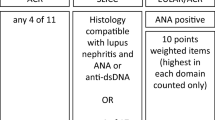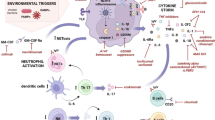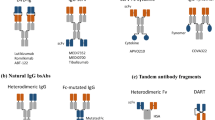Abstract
Soluble CD21 (sCD21) is the ectodomain of the CD21 glycoprotein released by shedding from the cellular membrane. The ectodomain of CD21 is capable of binding complement fragments, Epstein-Barr virus (EBV) and CD23. Functionally sCD21 can activate monocytes and abrogate B-cell/follicular dendritic cell interaction, thereby inhibiting antibody production by antigen primed B cells. Levels of sCD21 vary in several clinical conditions. Here we analyzed sCD21 in synovial fluids and sera in arthritic patients. sCD21 concentrations were consistently lower in synovial fluids compared to paired sera samples from the same patients. In contrast to healthy donors, sCD21 levels are significantly reduced in rheumatoid arthritis patient’s sera. Potential causes and consequences of the data are discussed.


Similar content being viewed by others
References
Corr M, Firestein GS (2002) Innate immunity as a hired gun: but is it rheumatoid arthritis? J Exp Med 195:F33–F35
Feldmann M, Brennan FM, Maini RN (1996) Rheumatoid arthritis. Cell 85:307–310
Harris EDJ (1997) Rheumatoid arthritis, 1 edn. W.B.Saunders, California
Mollnes TE, Lea T, Mellbye OJ, Pahle J, Grand O, Harboe M (1986) Complement activation in rheumatoid arthritis evaluated by C3dg and the terminal complement complex. Arthritis Rheum 29:715–721
Heaney ML, Golde DW (1998) Soluble receptors in human disease. J Leukoc Biol 64:135–146
Dello SP, Rovida E (2002) Transmodulation of cell surface regulatory molecules via ectodomain shedding. Biol Chem 383:69–83
Fearon DT, Carroll MC (2000) Regulation of B lymphocyte responses to foreign and self-antigens by the CD19/CD21 complex. Annu Rev Immunol 18:393–422
Ling NR, Brown B (1992) Properties of soluble CR2 in human serum. Immunobiology 185:403–414
Huemer HP, Larcher C, Prodinger WM, Petzer AL, Mitterer M, Falser N (1993) Determination of soluble CD21 as a parameter of B cell activation. Clin Exp Immunol 93:195–199
Fremeaux-Bacchi V, Aubry JP, Bonnefoy JY, Kazatchkine MD, Kolb JP, Fischer EM (1998) Soluble CD21 induces activation and differentiation of human monocytes through binding to membrane CD23. Eur J Immunol 28:4268–4274
Qin D, Wu J, Carroll MC, Burton GF, Szakal AK, Tew JG (1998) Evidence for an important interaction between a complement-derived CD21 ligand on follicular dendritic cells and CD21 on B cells in the initiation of IgG responses. J Immunol 161:4549–4554
Fremeaux-Bacchi V, Kolb JP, Rakotobe S, Kazatchkine MD, Fischer EM (1999) Functional properties of soluble CD21. Immunopharmacology 42:31–37
Illges H, Braun M, Peter HH, Melchers I (2000) Reduced expression of the complement receptor type 2 (CR2, CD21) by synovial fluid B and T lymphocytes. Clin Exp Immunol 122:270–276
Masilamani M, Seydlitz EV, Bastmeyer M, Illges H (2002) T cell activation induced by cross-linking CD3 and CD28 receptors leads to silencing of Epstein-Barr virus/C3d receptor (CR2/CD21) gene and protein expression. Immunobiology 206:528–536
Masilamani M, Nowack R, Witte T, Schlesier M, Warnatz K, Glocker MO, Peter HH, Illges H (2004) Reduction of Soluble Complement Receptor II/CD21 in Systemic Lupus Erythomatosus and Sjoegren’s Syndrome but not Juvenile Arthritis. Scand J Immunol (in press)
Masilamani M, von Kempis J, Illges H (2004) Decreased levels of serum soluble complement receptor-II (CR2/CD21) in patients with rheumatoid arthritis. Rheumatology (Oxford) 43:186–190
Arnett FC, Edworthy SM, Bloch DA, McShane DJ, Fries JF, Cooper NS, Healey LA, Kaplan SR, Liang MH, Luthra HS et al (1988) The American Rheumatism Association 1987 revised criteria for the classification of rheumatoid arthritis. Arthritis Rheum 31:315–324
Cronstein BN, Eberle MA, Gruber HE, Levin RI (1991) Methotrexate inhibits neutrophil function by stimulating adenosine release from connective tissue cells. Proc Natl Acad Sci U S A 88:2441–2445
Gu B, Bendall LJ, Wiley JS (1998) Adenosine triphosphate-induced shedding of CD23 and L-selectin (CD62L) from lymphocytes is mediated by the same receptor but different metalloproteases. Blood 92:946–951
Papiha SS, Pal B, Walker D, Mangion P, Hossain MA (1989) Alpha 1 antitrypsin (PI) phenotypes in two rheumatic diseases: a reappraisal of the association of PI subtypes in rheumatoid arthritis. Ann Rheum Dis 48:48–52
Reparon-Schuijt CC, van Esch WJ, van Kooten C, Levarht EW, Breedveld FC, Verweij CL (1998) Functional analysis of rheumatoid factor-producing B cells from the synovial fluid of rheumatoid arthritis patients. Arthritis Rheum 41:2211–2220
Masilamani M, Kassahn D, Mikkat S, Glocker MO, Illges H (2003) B cell activation leads to shedding of complement receptor type II (CR2/CD21). Eur J Immunol 33:2391–2397
Acknowledgements
This work was supported by the Hans-Hench-Stiftung, the Thurgauische Stiftung für Wissenschaft und Forschung through the Kanton Thurgau and the Bundesamt für Bildung und Wissenschaft (BBW), Bern, Switzerland through grant QLG1-CT-2001-01536 to HI.
Author information
Authors and Affiliations
Corresponding author
Rights and permissions
About this article
Cite this article
Grottenthaler, T., Kempis, J.v., Goldacker, S. et al. Soluble CD21 in sera and synovial fluid of arthritic patients. Rheumatol Int 26, 240–243 (2006). https://doi.org/10.1007/s00296-004-0541-2
Received:
Accepted:
Published:
Issue Date:
DOI: https://doi.org/10.1007/s00296-004-0541-2




